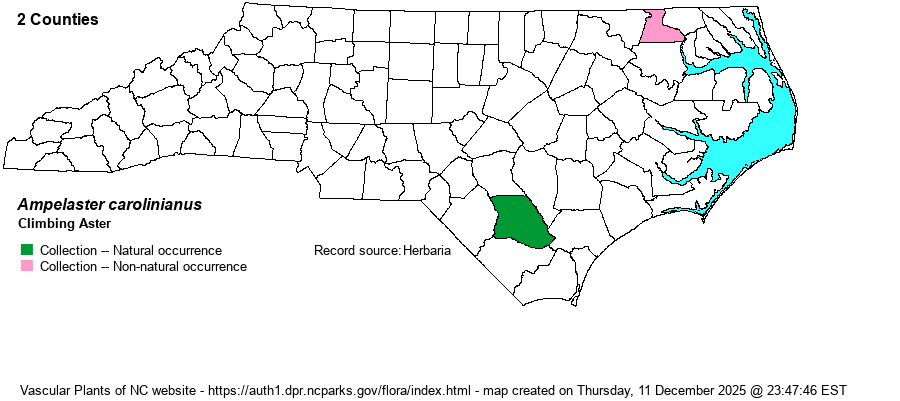| Author | (Walter) Nesom | |
| Distribution | Coastal Plain, at least formerly. There was historically a single valid specimen from NC: Bladen County, "pond, 4.8 miles southeast of Elizabethtown on NC 87", 19 October 1957, Ahles 37479 (NCU 130437). A specimen collected in 1948 "e. of Como, N.C.", in Hertford County, resided in the NCSC collection for decades as Aster novi-belgii has been determined by L.C. Anderson in 2012 to be the extremely rare Ampelaster carolinianus. This latter record seems to be at a non-natural locale and habitat, whereas the former was plausibly at a natural site.
Coastal Plain, NC to southern FL. | |
| Abundance | Considered of historical occurrence, based on the Bladen specimen, and thus NCNHP gives it a State Rank of SH. There has been some discussion whether that location was a natural site, or perhaps an escape, as the species is planted frequently. As the species is a wetland aster, it should be considered to have been a native species in NC formerly. | |
| Habitat | "Pond" in Bladen County, and "Old railroad grade" in NC. Elsewhere in its range, it occupies the margins of blackwater streams and rivers, fresh and tidal fresh marshes, and coastal hammocks. | |
| Phenology | Flowering and fruiting September-November. | |
| Identification | This unique aster clambers over supporting shrubs and small trees, rather vine-like. Stems are 3-6 feet long (or more), widely branched, leaves narrowly elliptic and 1-2.5 inches long. The flowers have numerous whitish to rosy pink rays and yellow disk florets. Many people are probably familiar with this species from plantings in gardens and arboretums, as it makes a very attractive "climbing" species. | |
| Taxonomic Comments | Ampelaster is a monotypic genus (it has only one species).
| |
| Other Common Name(s) | None | |
| State Rank | SH | |
| Global Rank | G5 | |
| State Status | | |
| US Status | | |
| USACE-agcp | OBL link |
| USACE-emp | FACW link |

